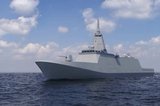US Navy looks to re-establish North Atlantic fleet
The US Navy (USN) will re-establish its Second Fleet to conduct maritime operations in the North Atlantic, in a move that could be interpreted as intended to counter Russian naval movements.
In a release issued by the US Navy on 4 May, it was revealed that the fleet will exercise operational and administrative authorities over assigned ships, aircraft and landing forces on the US’ east coast and northern Atlantic Ocean.
‘Our National Defence Strategy makes clear that we're back in an era of great power competition as the security environment continues to grow more challenging and complex,’ said USN chief of naval operations, Adm John Richardson.
‘That's why today, we're standing up Second Fleet to address these changes, particularly in the North Atlantic.’
Second Fleet was disestablished in 2011 and many of its personnel, assets and responsibilities were merged into US Fleet Forces.
Meanwhile the US DoD announced on 4 May that it had officially offered to host the proposed NATO Joint Force Command (JFC) for the Atlantic at its naval facilities in Norfolk, Virginia. The naval base is the largest such facility in the world, hosting dozens of warships and support vessels.
The DoD said that JFC-Norfolk would ‘ensure that NATO can successfully conduct operations across the full spectrum of alliance missions in the trans-Atlantic region’.
A decision of the final location of the facility will be made in the summer.
More from Naval Warfare
-
![Future Canadian Continental Defence Corvette will provide “Halifax-equivalent capabilities”]()
Future Canadian Continental Defence Corvette will provide “Halifax-equivalent capabilities”
Although the CDC project is still in its early stages, the Canadian Department of National Defence already has some requirements for the future platforms.
-
![US Navy to acquire micro-uncrewed underwater vehicles for ISR and coastal data collection]()
US Navy to acquire micro-uncrewed underwater vehicles for ISR and coastal data collection
The Naval Supply Systems Command is seeking authorised resellers of JaiaBot uncrewed underwater vehicles and multivehicle pods. The platforms will support undergraduate education at the US Naval Academy.
-
![NATO tests use of “undetectable, jam-proof” laser communication in maritime scenarios]()
NATO tests use of “undetectable, jam-proof” laser communication in maritime scenarios
As part of its effort to better prepare its capabilities for operations in contested and congested scenarios, NATO evaluated a Lithuanian ship-to-ship terminal designed to not be susceptible to enemy interference.
-
![Future of the Canadian Patrol Submarine Project is still unclear]()
Future of the Canadian Patrol Submarine Project is still unclear
The Canadian government remains tight-lipped on the timeline and funding required for the next steps of its Canadian Submarine Patrol Project, which should offer improved capabilities for the country’s navy.
-
![Mitsubishi eyes future with Australia’s Mogami selection]()
Mitsubishi eyes future with Australia’s Mogami selection
With Australia’s selection of the Mogami-class for Project Sea 3000, Mitsubishi is investigating local production in the next decade as potential export opportunities emerge.
























